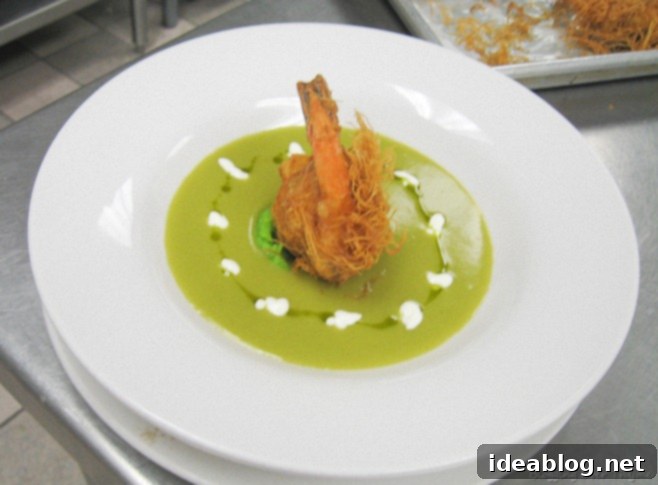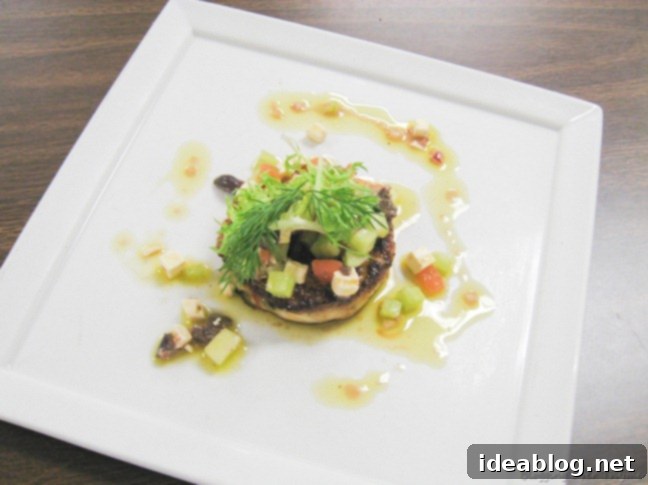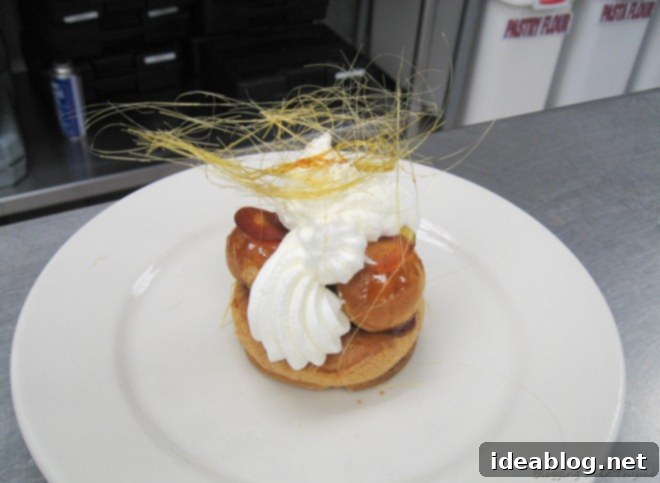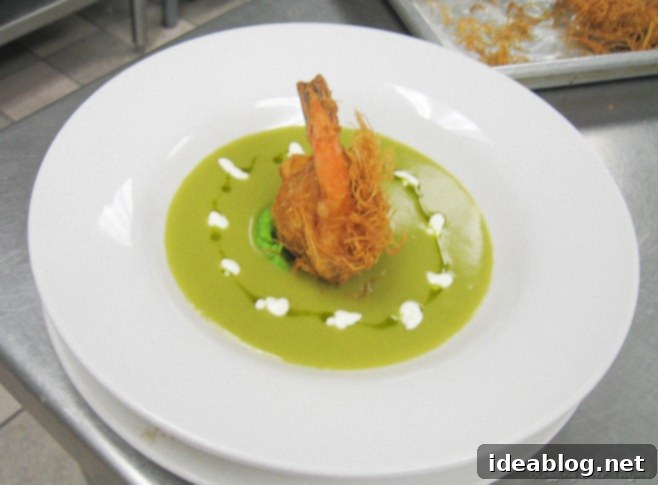A Culinary Journey: Mastering Split Pea Soup, Gourmet Crab Cakes, and Classic Saint Honoré
Stepping into the professional kitchen each day brings a fresh set of challenges and delicious rewards. Today’s menu was an exhilarating exploration of classic techniques and innovative flavors, demanding precision, creativity, and a keen eye for detail. From intricate garnishes to foundational French pastry, every dish presented a valuable learning opportunity. Join me as we delve into the preparation of our three featured courses: a vibrant Split Pea Soup, a sophisticated Scallop Mousse Crab Cake, and the exquisitely complex Saint Honoré dessert.
First Course: Velvety Split Pea Soup with Crispy Kataifi Shrimp
Despite my deep affection for all legumes, today marked my inaugural experience cooking with split peas – a delightful surprise that yielded a remarkably comforting and flavorful soup. The process itself was refreshingly straightforward, laying a solid foundation for more complex culinary adventures.

The Base: A Flavorful Foundation for the Soup
Our journey began with creating an aromatic base, characteristic of many classic French potages. We gently sweated finely diced leeks and celery until they were tender and translucent, carefully coaxing out their sweet, earthy notes without allowing them to brown. This careful process ensures a clean, foundational flavor without any bitterness. To this fragrant foundation, we introduced a small amount of diced bacon. This addition wasn’t merely for bulk but served a crucial purpose: to impart a subtle smokiness and a layer of umami that deeply enhanced the soup’s overall character without overpowering the delicate pea flavor. Once the bacon rendered its fat and crisped slightly, we added the split peas and generously covered them with quality chicken stock. The mixture was then brought to a gentle simmer, allowing the split peas to slowly break down and become incredibly tender, naturally developing a rich, creamy texture over time.
Achieving Perfect Color and Silky Smooth Texture
Once the peas reached their ideal tenderness, the soup was ready for refinement. We transferred it to a high-speed Vitamix blender – a significant upgrade from the basic blenders we struggled with in Phase I. This powerful tool effortlessly pureed the soup to an incredibly smooth, silky consistency, far superior to what a conventional blender can achieve. Following the blending, we passed the soup through a fine-mesh chinois. This extra, meticulous step is essential in professional kitchens, ensuring every last fiber is removed, resulting in an impeccably smooth, restaurant-quality mouthfeel that truly elevates the dish.
And then came a fascinating little trick! While delicious, split pea soup can sometimes develop a rather dull, brownish-green hue. To counter this, we added literally a single drop of green food coloring. I know it sounds unconventional, perhaps even a little cheeky, but the quantity was so minuscule that it was utterly undetectable by taste or sight. Its sole purpose was to subtly brighten the soup’s natural color, making it visually more appealing – a testament to the aesthetic considerations in professional cooking. To maintain this beautiful texture and prevent an unsightly film from forming on the surface (a common issue with pureed soups), we immediately covered the pots with heavy-duty plastic wrap, pressed directly onto the soup’s surface. This simple yet effective technique works flawlessly, preserving the soup’s pristine quality and ready for service.
The Garnish: Crispy Kataifi Shrimp for Added Dimension
No gourmet soup is complete without an equally impressive garnish, and ours was certainly no exception. We prepared a delicate fried shrimp, which began by dipping succulent shrimp into a light batter made from eggs, finely minced jalapeño for a hint of spice, spring onion for freshness, and shallot for aromatic depth. The true innovation, however, lay in its outer coating: kataifi. This incredible product, also known as shredded phyllo dough, provided an extraordinary textural element. Prior to this lesson, I had never encountered kataifi, but its ability to transform into an incredibly light, crispy, and visually striking layer upon frying, without imparting any significant flavor, was truly impressive. It added a delightful crunch that contrasted beautifully with the velvety soup, offering a complex sensory experience.
Elegant Plating: A Culinary Art Form
The presentation of the soup was as thoughtful as its preparation, showcasing a crucial aspect of fine dining. You might wonder how the fried shrimp managed to stand so elegantly upright in the bowl without succumbing to the soup’s warmth and becoming soggy. The solution was ingenious: we meticulously placed a small, circular mound of pea puree (formed using a precise culinary mold) directly in the center of the bowl. The vibrant green soup was then carefully poured around this pea puree island, creating a visual halo. Finally, the crispy fried shrimp was gently but firmly pressed into the pea puree, providing a stable anchor and ensuring it remained upright and crisp. The final touches included a swirl of bright chive oil (provided by our instructors) and a dollop of rich sour cream, adding both visual appeal and complementary flavors that enhanced the overall taste profile. The result was not only a feast for the eyes but an absolute delight to the palate, demonstrating how thoughtful plating elevates a dish.
Main Course: Gourmet Scallop Mousse Crab Cakes with Greek Salad Garnish
Our main course offered a refreshing change of pace and showcased an innovative approach to a beloved classic. We proudly served a meticulously crafted crab cake, elegantly paired with a fresh, vibrant Greek salad garnish, lightly tossed in a classic sherry vinegar and olive oil vinaigrette.

Rethinking the Crab Cake: Scallop Mousse Innovation
What truly set our crab cakes apart was a revolutionary binding agent that elevated their flavor and texture. Unlike most conventional recipes that rely on breadcrumbs or eggs, which can often dilute the delicate flavor of the crab, we utilized a beautifully light and flavorful scallop mousse. This exquisite mousse, prepared by blending fresh, sweet scallops with rich heavy cream, served a dual purpose: it bound the premium lump crab meat together perfectly while simultaneously enhancing the overall seafood essence of the dish. The result was a crab cake with an incredibly smooth, tender texture that melted in the mouth, allowing the sweet, succulent crab to be the undisputed star. This ingenious technique resonated deeply with my culinary philosophy – I believe a gourmet crab cake should taste almost entirely of crab, free from unnecessary fillers that detract from its natural goodness and quality.
The Perfect Blend: Flavor, Texture, and Professional Execution
Into our generous portions of lump crabmeat and the delicate scallop mousse mixture, we carefully folded in a medley of finely diced and sautéed red and green bell peppers, minced garlic, and shallots. These ingredients contributed not only vibrant color and visual appeal but also a subtle sweetness and aromatic depth, complementing the seafood beautifully. To elevate the flavor profile further, we seasoned the mixture generously with the iconic Old Bay seasoning, a classic choice that perfectly complements seafood and evokes a sense of tradition. Once thoroughly combined, the crab cake mixture was carefully molded into uniform patties, ensuring even cooking and consistent presentation. A crucial step often overlooked is chilling the molded crab cakes for at least 30 minutes. This firms them up considerably, preventing them from falling apart during cooking and ensuring they retain their perfect shape. Finally, they were seared to a beautiful golden-brown in clarified butter, achieving a wonderfully crisp exterior that yielded to a tender, flavorful interior. Simply delicious and executed with precision!
A Refreshing Accompaniment: The Balancing Greek Salad
The accompanying Greek salad was far more than a mere side dish; it was a thoughtfully chosen component that provided essential balance to the rich crab cake. Its crisp, refreshing qualities, featuring fresh tomatoes, cucumbers, olives, and feta, along with the tangy acidity from the sherry vinegar and olive oil vinaigrette, cut through the creaminess and richness of the crab cake beautifully. This pairing, something I would never have considered before my advanced culinary training, demonstrated the importance of contrasting textures and flavors in creating a harmonious and memorable dining experience. The salty brininess of the olives and feta in the salad also offered a delightful counterpoint to the sweet crab, creating an incredibly well-rounded and satisfying main course that left a lasting impression on the palate.
Dessert: The Exquisite Saint Honoré
To culminate our culinary exploration, we tackled the challenge of preparing the Saint Honoré, a truly iconic and highly traditional French dessert. This architectural marvel of pastry seamlessly integrates several classic components: a crisp pâte sucrée (sweet shortcrust pastry), delicate pâte à choux (choux pastry), luscious pastry cream, shimmering caramel, and airy whipped cream. This dessert, I must confess, was significantly time-consuming, a true test of our pastry skills and patience, requiring meticulous attention to detail at every stage. Thankfully, we had a supply of leftover pâte sucrée from a previous lesson, which provided a small head start. However, the majority of the intricate components were meticulously prepared from scratch during our intensive production session, showcasing our commitment to traditional methods.

Assembling a French Classic: A Multi-Layered Masterpiece
The assembly of the Saint Honoré is a multi-step ballet of pastry techniques, demanding precision and artistic flair. It begins with rolling out a round disc of pâte sucrée, which forms the sturdy, buttery base of the dessert. Around the perimeter of this disc, we piped a continuous circle of pâte à choux, which, once baked, expands to create a delightful, airy border. Simultaneously, traditional individual pâte à choux balls were baked to golden perfection, puffing up beautifully. These delicate spheres were then generously piped with a rich, velvety pastry cream, luxuriously flavored with a hint of rum, adding an extra layer of warmth and complexity that distinguishes a truly gourmet dessert. The magic truly began with the caramel. Each cream-filled choux puff was carefully dipped into shimmering, molten caramel, ensuring a glossy, protective coating and a satisfying crunch. These glazed puffs were then delicately “glued” onto the baked pâte sucrée and pâte à choux base using more caramel, creating a beautiful crown effect. A flat disc of caramel was artfully added to the top of each choux puff for an elegant, reflective finish. The central hollow of the base was then generously filled with any remaining pastry cream, creating a delightful reservoir of richness, before being crowned with swirls of freshly whipped cream, adding a final touch of lightness and decadence to this architectural sweet treat.
The Delicate Art of Spun Sugar
Once our caramel was ready, we were introduced to another captivating pastry technique: creating spun sugar. This delicate art requires a very specific caramel temperature – cooled enough to be pliable and viscous, but not yet cold and brittle. The technique involves using a fork to drizzle thin strands of caramel, which are then quickly gathered towards oneself with a swift, repetitive motion, forming ethereal, hair-like threads. The sugar rapidly dries and hardens in the air, leaving you with exquisite, gossamer-thin spun sugar, perfect for a decorative flourish that adds visual drama to any dessert. It sounds simple, but I must admit, it’s considerably easier said than done! Precision, speed, a steady hand, and an understanding of caramel’s temperamental nature are paramount. However, after a few attempts and some collaborative effort, my partner Jim and I eventually managed to produce some beautiful results, a testament to persistence and teamwork in the face of a challenging technique.
Lessons Learned (and Burns Earned) in the Kitchen
Unfortunately, the allure of molten caramel comes with a significant occupational hazard that many pastry chefs know all too well. Dipping the hot choux balls into the caramel left me with a tiny, albeit painfully sharp, burn on the tip of my finger. I was certainly not alone; four out of my ten classmates also experienced similar caramel-related mishaps that day. Caramel burns are notoriously excruciatingly painful – my sister once suffered a severe one at culinary school that nearly required a skin graft due to its intensity. Thankfully, mine was very small, a minor inconvenience compared to the valuable lessons learned about working with such temperamental ingredients and the paramount importance of extreme caution and proper technique in the professional kitchen. It was a stark reminder that culinary artistry often involves a touch of danger and requires unwavering respect for the ingredients and tools.
Reflection on the Culinary Journey and Progress
All in all, it was an incredibly eventful and rewarding day in the kitchen, filled with both challenges and triumphs. Beyond the mastery of specific dishes and techniques, we also had the opportunity to briefly observe the new Phase I Culinary students. It was a strangely nostalgic experience, serving as a powerful reminder of how far we, as Phase II students, have progressed and refined our skills in just three short months. It was truly amazing to see the foundational techniques we now execute almost instinctively being introduced to a new group of aspiring chefs, sparking memories of our own beginnings. We also had the pleasure of greeting Chef Somchet, Chef Brian, and Ashley again, marking our first interaction since successfully advancing to Phase II. Their continued guidance, expertise, and support are invaluable as we delve deeper into advanced culinary arts and navigate increasingly complex recipes. Overall, it was a profoundly good day, setting a high standard and a positive, energized tone for the second week of this intensive culinary phase, and reaffirming our passion for the craft.
